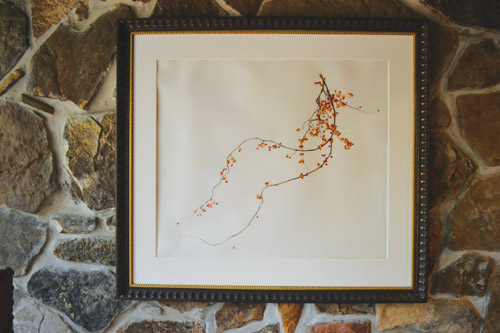
By Judy Loving
Style by Kelly Householder-Giuliano
Photography by Deb Peterson
I am pretty sure that my art collection started with a stoneware mug. There was an inkling of an idea that even as an unemployed college student, I could afford to collect art in small, incremental ways if I limited my spending to needed, functional items.
The mug was created at Calabash Pottery, a women-owned studio and shop just off Dickson Street in Fayetteville. Its handle was large enough to grip with my entire hand and the thin-walled mug was the perfect size for a cup of tea or coffee in the morning. The color was rusty oatmeal, with an earth-toned base. Mugs were inexpensive in the mid 70s and I splurged. I bought two.
To this day, the early pots that I collected remain beloved. I find comfort and a deep restful pleasure when touching or looking at them. In many cases I have met the artists, and the human connection through art adds warmth to the visual experience. Most of my pottery is from Arkansas.

Currently I also collect early, hand-thrown Niloak Pottery. In 1906, Eagle Pottery Company of Benton, Arkansas worked with kaolin (a fine potter’s clay) of several distinctive color combinations swirled together in a unique, mission-style design. The company discontinued making Niloak (kaolin spelled backwards) pottery in 1926. Scouring flea markets and antique stores, Bob and I hunt for color combinations and shapes that appeal to us.
Why is art a crucial focal point for so many? Our genes meet the world and we decorate accordingly.
We live our lives as who we are. Our environment evolves and grows organically around us while, to whatever extent we can, we make conscious choices to shape that environment; we adorn our bodies and our homes.

I do not think that people always deliberately define themselves with the art they choose to live with. But it is not haphazard either. Piece by piece, small choices and large choices, we replicate our sense of beauty and our interests. Our eyes reflect what resonates within us.
Primarily limiting my collection to art from Arkansas helped hone my focus. Beyond my love of family and friends, my joys in life come from the rustic and the out-of-doors. I purposely seek items that reflect these interests. I also think that as a species, humans share a legacy of bringing the beauty of the out-of-doors into our shelters. It keeps nature close. Personal.
I expanded my collection with hanging-on-the-wall art, mostly posters purchased from art museums I visited. Over the years I added prints from Susan Morrison and Duane Hada, both Arkansas artists. In 2001, a friend gave me a poster of wildflowers from the Baker Prairie near Harrison. It was part of a touring exhibit by Arkansas botanical artist, Kate Nessler, commissioned by the Arkansas Natural Heritage Commission to document indigenous plants of the state. Getting to know Kate Nessler’s work was a turning point in my art collection. I am honored and humbled to live with several of her paintings.

Kate Nessler lives near Kingston, Arkansas. She paints primarily with watercolor on vellum. Nessler is an extraordinary botanical artist whose works are shown in the United States and in England. Two of her paintings were included in Shirley Sherwood’s 2005 book, A New Flowering — 1000 Years of Botanical Art, and she has two entries in Fresh Cut, the 2005 exhibition catalogue of the American Society of Botanical Artists. She served as president of the American Society of Botanical Artists and received its prestigious Award of Excellence in 1997. Her paintings are in the Hunt Institute, and in the Lindley Library of the Royal Horticultural Society. Her work was selected for inclusion in the Highgrove Florilegium. She painted two watercolors under the umbrella of the Prince of Wales Charitable Foundation to celebrate and record the flora in the garden at Highgrove, the country estate of Prince Charles in Tetbury. Locally, you can view a Nessler painting at the Donald W. Reynolds Library in Mountain Home.

I find great joy when looking at Nessler’s work. I see life’s resilience rushing through frail fallen petals. I see death and rebirth in a spray of bittersweet. Nessler eloquently captures the audacious helter-skelter construction of a bird’s nest simultaneously with its strength to withstand the rages of weather.
Purchasing art supports artists, and that is a remarkable thing to do. Bob and I give art as gifts to close friends and family. Close friends share art with us. It bolsters our sense of what is important in life and deepens the intimacy of our relationships.
In 1987, a group of women with vision in Washington DC had the idea that women artists were underappreciated mostly because they were unknown. In order to correct the situation, and subsequently raise the status and pay scale of women artists, this group created the National Museum of Women in the Arts. Women artists now have a museum of their own. Membership was on a grass roots level. For $35 you could become a charter member of an art museum! As an underpaid teacher in Arkansas, I mailed in the $35 and to this day I remain a very proud member of NMWA. My annual contributions increase over the years as fate allows.

Beyond the art on our shelves and walls, our kitchen is a major expression of our love and interests and, like the kitchens of many of our friends, is fabulous to behold. After forty years I continue refining its look, its tenor, and its aromas. If I have any creative ability, the kitchen is where it seeks voice.
Significant meals and notable mistakes spring from my kitchen in random abandon. Like life, it is a place of anxiety and peace, and in the end, there is laughter. Surrounded by Arkansas pottery and in view of two Nessler paintings, inspiration comes easily to our kitchen.
My younger daughter, Attila Berry, explains it best in an essay she wrote twenty years ago:
My family’s personal epicenter is in the kitchen.
It is the first room that is visible when coming in the front door and its aroma is the first thing smelled when entering through the back. It is not isolated from the rest of the house but integrated into the living room and dining area with no separation. With a very humble start, it eventually changed into an efficient and intricate work of art. The kitchen is compact and productive, and the heart of our house resides within it.
Within its warmth my family becomes, all of our oddities and idiosyncrasies aside, a cohesive unit. We each do our own part in helping to prepare a meal whether that be perfecting a Crème Anglaise or stir-frying shrimp. I like just to watch the flurry of culinary activity unfold around me. The sights and sounds of our kitchen, the simmering and chopping and the strong scent of cilantro all merge together to produce a feeling of connectedness between the participants.

There is a clear and definite flow to the kitchen. It is a rhythm to which we all abide. It resembles a song, carefully composed and full of recipes and vegetables and love for each other. In the kitchen my family sits on the brink of harmony, and in order for other people to join in the cooking process, they must be very observant. Otherwise, they are lost in a maze of pots and measuring cups. In most families emphasis is placed on the eating of food rather than the process used to make it. With my family it is the exact opposite. To us the preparation is exceedingly more important than the actual eating. Consumption is an afterthought.
The kitchen is a multifaceted area. It is used to prepare meals and provides a place for communication.
Upon entering the kitchen, good conversations and in-depth discussions are inevitable. My mother and I perch on the cool, granite counters and talk for hours about the joys and demons in our lives. Expression comes more easily in the warmth of the stove and the smell of oregano and freshly baked bread.
We are a kitchen family and perhaps that is why it has such a profound effect on me. The hustle and bustle of everyday life is forgotten when I see my family each playing their own part in calm delight. My future has a menagerie of options and I am constantly bombarded with dreams and aspirations that may or may not come true. The one thing I know, though, is that I want to have a home as connected and contented as my family’s kitchen.
Homes, by definition, are places of nourishment. Whether a modest cabin or a hilltop estate, a home offers safety. Homes provide nurturing and sanctuary, places where people love each other and thrive.
I think often of the Syrians who leave their homes because of the strife and fear besieging them. How do they choose what to take? How did displaced Jews choose what to load on their backs and in their carts? Do you ever take a piece of art? Or photos of loved ones?
More often I think of Lot’s nameless wife. In the story, she was forced to leave her house—driven away, following her husband. And in her heart, she turns with a silent farewell to the home that had sheltered her family. I think that she was a wondrous homemaker amid the chaos of Sodom. She must have truly loved the home that she created to disobey a wrathful God. She was turned to salt. Salt, the essential mineral, displayed on every kitchen table. M! June/July 2017
